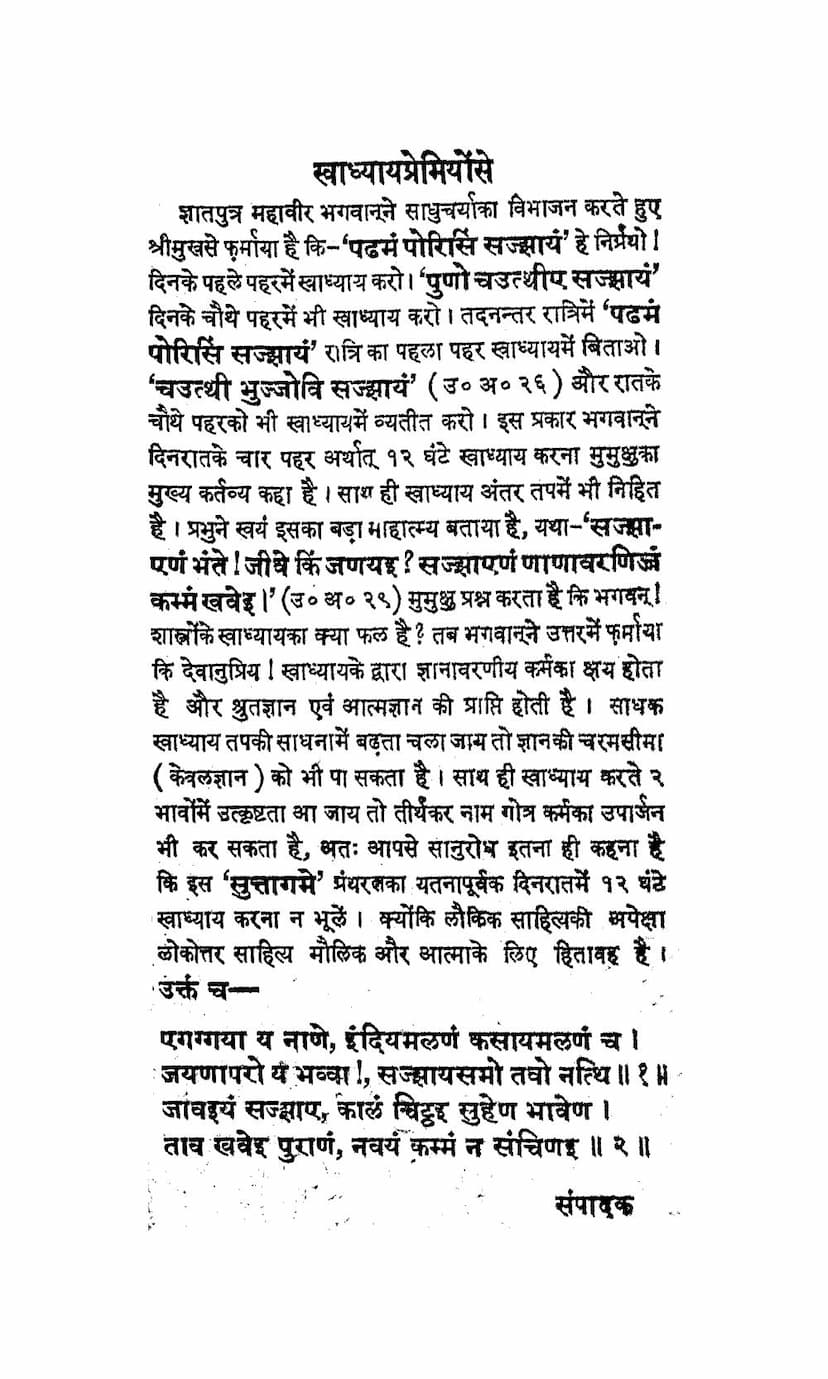Suttagame 02
Added to library: September 2, 2025

Summary
The provided Jain text, "Suttagame 02" by Fulchand Maharaj, is a comprehensive collection of Jain scriptures. The catalog link points to the second volume of the Sutragama, containing 21 sutras. Based on the provided pages, the text focuses on the importance and practice of Swadhyaya (self-study) as a key duty for spiritual seekers, highlighting its role in shedding karmic obstructions and attaining spiritual knowledge, potentially leading to Kevalgyan (omniscience) and even the acquisition of Tirthankar Nam-gotra (the lineage karma of a Tirthankar).
Here's a breakdown of the key themes and content from the provided pages:
1. Emphasis on Swadhyaya (Self-Study):
- Mandatory Practice: The text begins by quoting Lord Mahavir's instruction to practice Swadhyaya during the first and fourth parts of both the day and night, totaling 12 hours of study.
- Spiritual Benefits: Swadhyaya is presented as an "antara tapa" (internal austerity) that leads to the destruction of Jnana-avaraniya karma (knowledge-obscuring karma) and the attainment of Shruta-jnana (scriptural knowledge) and Atma-jnana (self-knowledge).
- Higher Attainments: Consistent Swadhyaya can lead to the ultimate goal of Kevalgyan (omniscience) and even the earning of Tirthankar Nam-gotra.
- Superiority of Spiritual Literature: The text emphasizes that spiritual literature (lokottara sahitya) is superior and more beneficial for the soul than worldly literature (laukika sahitya).
- Key Verses: Two verses are quoted to underscore the value of Swadhyaya:
- "One-pointedness in knowledge, eradication of impurities of senses and passions, and carefulness lead to the highest state; there is no penance equal to Swadhyaya."
- "As much time as one spends in Swadhyaya with virtuous feelings, that much past karma is destroyed, and new karma is not accumulated."
2. The Sutragama Prakashak Samiti (Sutra Agama Publication Committee):
- Motivation for Establishment: The establishment of this committee was inspired by a farmer's question to Muni Fulchandji Maharaj about the availability of Jain scriptures in printed book format, similar to the Vedas. The lack of such publications was noted as a significant deficiency.
- Mission: The committee aims to publish the 32 Agamas (Jain scriptures) in at least 100 vernacular languages, with 100,000 copies of each. This is a massive undertaking to spread Jain principles throughout India.
- Methodology: The publication follows the "Sautrika riti" (traditional compilation method) of Sutragama, Arthagama, and Ubhayagama.
- Current Publication: "Suttagame Volume II" is presented as the second part of this series, containing 21 sutras (including 12 Upangas, 4 Chedas, 4 Mulas, and 1 Avashyaka). The first volume, containing 11 Angas, was previously published.
- Appeal for Support: The committee appeals to Jain scholars and householders to support this noble cause by studying their publications, fostering Swadhyaya within their families, and contributing financially.
3. Content of Sutragama Volume II (as inferred from the description):
- The volume contains 21 sutras, likely encompassing the remaining Upangas, Chedas, and Mulas Sutras of the Jain Agamas. The text explicitly mentions 12 Upangas, 4 Chedas, 4 Mulas, and 1 Avashyaka, totaling 21 sutras.
- The text implies a critical editing process by Muni Shri Fulchandji Maharaj, suggesting attention to textual accuracy.
4. Praise and Testimonials:
- Several individuals, including Muni Shri Nanchandji, Muni Shri Shamji Swami, Muni Shri Hirallalji, Muni Shri Ratanchandji, and scholars like Prof. Daniel H. H. Ingals from Cambridge, have provided positive feedback and commendations for the publication.
- These testimonials highlight the beautiful binding, quality paper, scholarly editing, purification of texts, and the immense value of these publications for Swadhyaya and the propagation of Jain teachings.
5. Comparative Study (Dash Vidh Niyam):
- The text includes a section discussing the "ten rules of Jainism," touching upon fundamental principles like the nature of soul and matter, karma, liberation, right belief, right knowledge, right conduct, compassion, control of senses, austerity, non-possession, non-violence, and the concept of Syadvada.
- It also draws parallels and points out similarities between Jain teachings and those found in Buddhism and Vedic traditions, particularly regarding ethical conduct and philosophical concepts. The text lists examples of Jain verses that resemble or echo sentiments found in Buddhist literature like the Dhammapada.
6. Language and Style:
- The text is primarily in Hindi, with devotional salutations to Lord Mahavir and Muni Fulchandji Maharaj.
- There are also sections in Prakrit and Sanskrit, reflecting the layered nature of Jain scriptural study.
- The language is eloquent and persuasive, aiming to instill enthusiasm for scripture study and propagation.
7. Detailed Table of Contents/Structure of Agamas (implied by the mention of 32 sutras and their divisions):
- The text implicitly outlines the structure of the Jain Agamas, mentioning 11 Angas, 12 Upangas, 4 Cheda Sutras, 4 Mula Sutras, and the Avashyaka Sutra, totaling 32 primary scriptures.
- It also references Arthagama (commentaries/interpretations) and Ubhayagama (texts containing both original and commentary).
8. Emphasis on Purity and Accuracy:
- The introduction and testimonials suggest a strong focus on textual purity and accuracy in the publication, aiming to present the original teachings of Lord Mahavir without interpolation or distortion.
Overall Summary:
The provided pages of "Suttagame 02" by Fulchand Maharaj, as presented by the Sutragama Prakashaka Samiti, strongly advocate for the vital importance of Swadhyaya in the Jain path to liberation. It highlights the profound spiritual benefits of studying the scriptures diligently, as prescribed by Lord Mahavir. The text also serves as a testament to the committee's dedication to making these ancient teachings accessible through modern publications, thereby fulfilling a crucial need for the dissemination of Jain philosophy. The inclusion of testimonials and a comparative study underscores the scholarly and dedicated approach of the publication, aiming to revive and promote the study of Jain Agamas.
It's important to note that this summary is based solely on the provided textual snippets. A complete understanding of the Sutragama requires a full reading and study of the entire work.